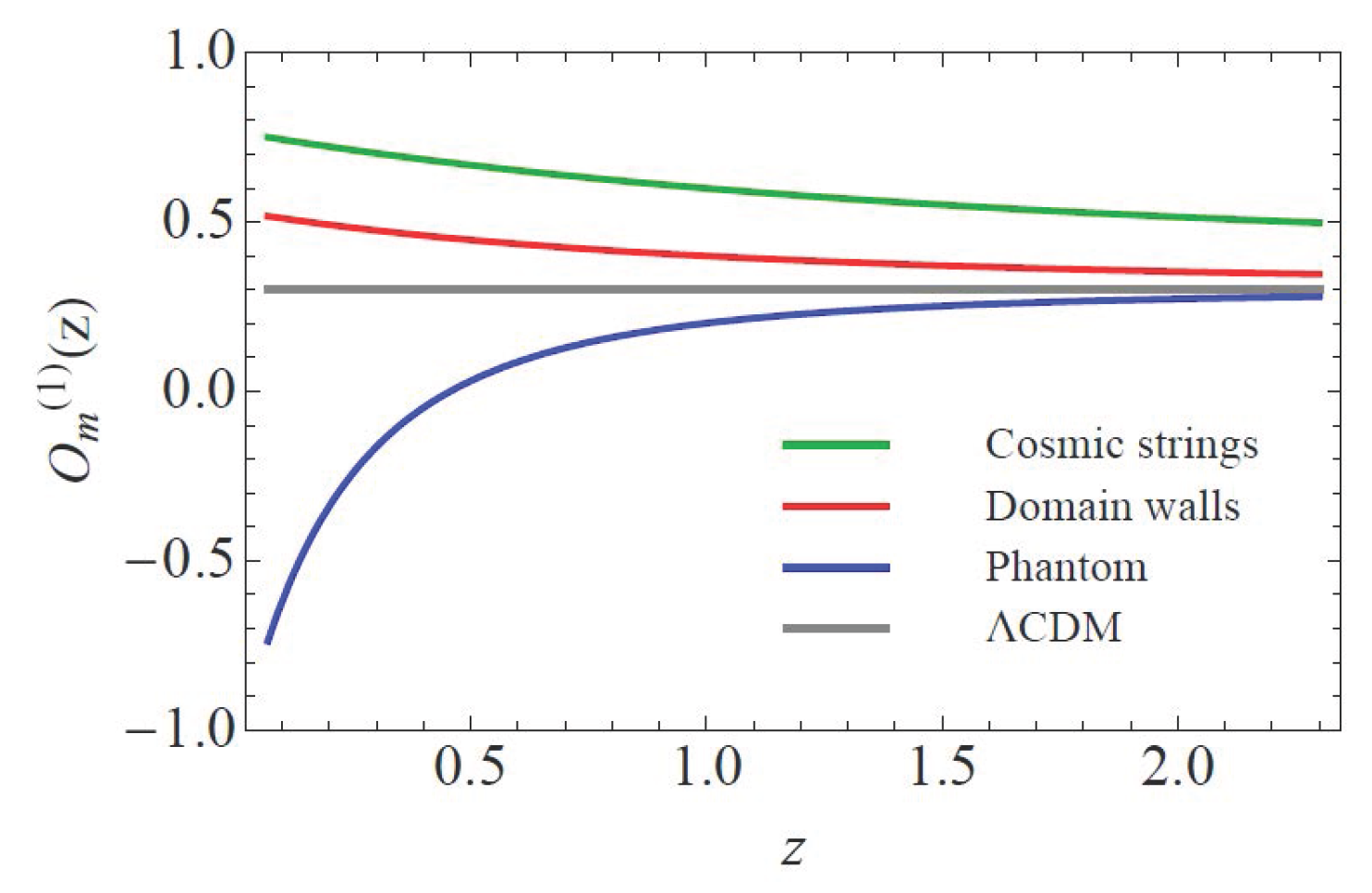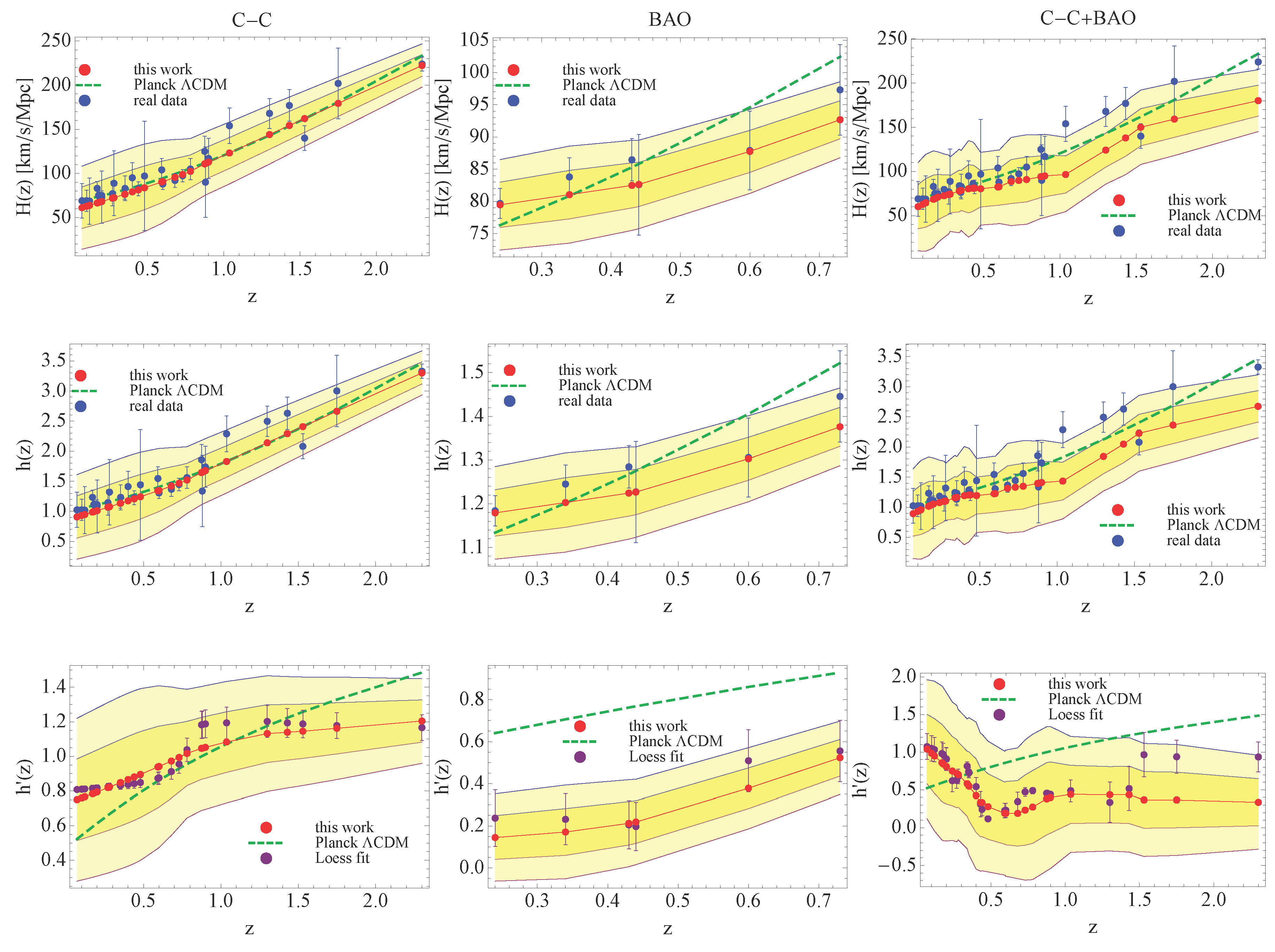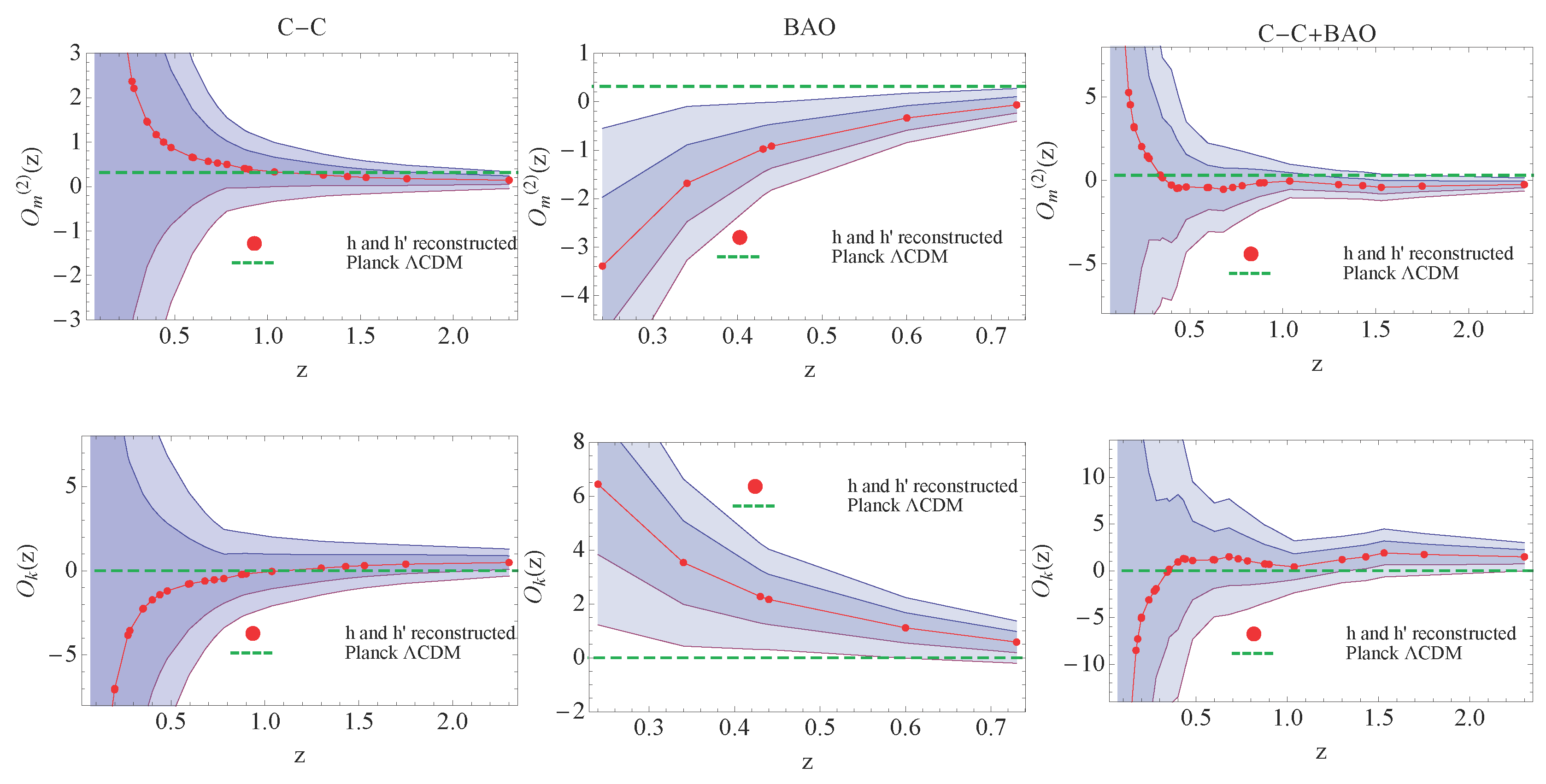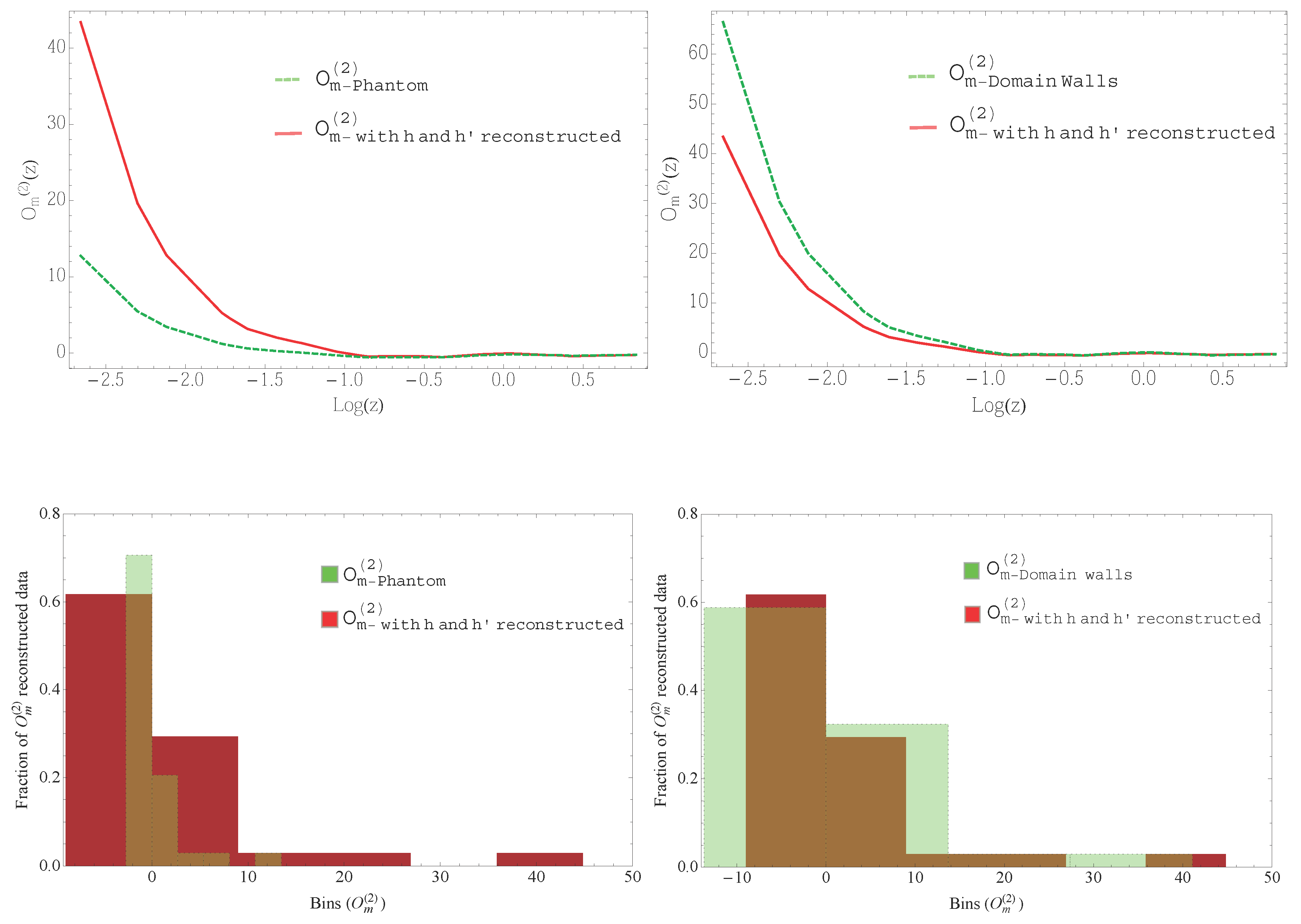Nonparametric Reconstruction of the Om Diagnostic to Test ΛCDM
Abstract
:1. Introduction
2. ΛCDM Background
3. The Om Diagnostic Background
4. The Dynamical Om Diagnostic
5. Observations of the Hubble Rate
- (1)
- Cosmic Chronometers (C-C) data. This kind of sample gives a measurement of the expansion rate without relying on the nature of the metric between the chronometer and us. We are going to employ several data sets presented in [28]. A full compilation of the latter, which includes 28 measurements of in the range , are reported in [50]. The normalized parameter can be easily determined by considering the value km s−1 M pc−1 [46].
- (2)
- Data from BAO. Unlike the angular diameter measures given by the transverse BAO scale, the data can be extracted from the measurements of the line-of-sight of this BAO scale. Because the BAO distance scale is embodied in the CMB, its measurements on DE parameters are strongest at low redshift. The samples that we are going to consider consist of three data points from [34] and three more from [35] measured at six redshifts in the range . This data set is shown in Table 2.
6. Nonparametric Reconstructions
6.1. Reconstruction of
6.2. Reconstruction of
6.3. Nonparametric Reconstruction of the Diagnostic
7. Discussion and Conclusions
Acknowledgments
Author Contributions
Conflicts of Interest
Appendix A. Reconstruction of D(z)
- If we have a flat universe (), then the equations are
- For the case of a non-flat universe (), we have
- For and ,
- For and ,
- For and ,
- For and ,
References
- Laureijs, R.; Amiaux, J.; Arduini, S.; Auguères, J.-L.; Brinchmann, J.; Cole, R.; Cropper, M.; Dabin, C.; Duvet, L.; Ealet, A.; et al. Euclid Definition Study Report. arXiv 2011. [Google Scholar]
- Amendola, L.; Appleby, S.; Bacon, D.; Baker, T.; Baldi, M.; Bartolo, N.; Blanchard, A.; Bonvin, C.; Borgani, S.; Branchini, E.; et al. Cosmology and fundamental physics with the Euclid satellite. Living Rev. Relativ. 2013, 16, 6. [Google Scholar] [CrossRef]
- Samushia, L.; Reid, B.A.; White, M.; Percival, W.J.; Cuesta, A.J.; Zhao, G.; Ross, A.J.; Manera, M.; Aubourg, É.; Beutler, F.; et al. The Clustering of Galaxies in the SDSS-III Baryon Oscillation Spectroscopic Survey (BOSS): Measuring growth rate and geometry with anisotropic clustering. Mon. Not. R. Astron. Soc. 2014, 439, 3504–3519. [Google Scholar] [CrossRef]
- Abdalla, F.; Annis, J.; Bacon, D.; Bridle, S.; Castander, F.; Colless, M.; DePoy, D.; Diehl, H.T.; Eriksen, M.; Flaugher, B.; et al. The Dark Energy Spectrometer (DESpec): A Multi-Fiber Spectroscopic Upgrade of the Dark Energy Camera and Survey for the Blanco Telescope; Fermi National Accelerator Laboratory (FNAL): Batavia, IL, USA, 2012.
- Myers, S.T.; Abdalla, F.B.; Blake, C.; Koopmans, L.; Lazio, J.; Rawling, S. The Billion Galaxy Cosmological HI Large Deep Survey. In Astro2010: The Astronomy and Astrophysics Decadal Survey; The National Research Council of the National Academy of Sciences: Washington, DC, USA, 2009. [Google Scholar]
- Riess, A.G.; Filippenko, A.V.; Challis, P.; Clocchiattia, A.; Diercks, A.; Garnavich, P.M.; Gilliland, R.L.; Hogan, C.J.; Jha, S.; Kirshner, R.P.; et al. Observational Evidence from Supernovae for an Accelerating Universe and a Cosmological Constant. Astron. J. 1998, 116, 1009–1038. [Google Scholar] [CrossRef]
- Perlmutter, S.; Aldering, G.; Goldhaber, G.; Knop, R.A.; Nugent, P.; Castro, P.G.; Deustua, S.; Fabbro, S.; Goobar, A.; Groom, D.E.; et al. Measurements of Omega and Lambda from 42 High-Redshift Supernovae. Astrophys. J. 1999, 517, 565–586. [Google Scholar] [CrossRef]
- Eisenstein, D.J.; Zehavi, I.; Hogg, D.W.; Scoccimarro, R.; Blanton, M.R.; Nichol, R.C.; Scranton, R.; Seo, H.; Tegmark, M.; Zheng, Z.; et al. Detection of the Baryon Acoustic Peak in the Large-Scale Correlation Function of SDSS Luminous Red Galaxies. Astrophys. J. 2005, 633, 560–574. [Google Scholar] [CrossRef]
- Spergel, D.N.; Verde, L.; Peiris, H.V.; Komatsu, E.; Nolta, M.R.; Bennett, C.L.; Halpern, M.; Hinshaw, G.; Jarosik, N.; Kogut, A.; et al. First Year Wilkinson Microwave Anisotropy Probe (WMAP) Observations: Determination of Cosmological Parameters. Astrophys. J. Suppl. 2003, 148, 175–194. [Google Scholar] [CrossRef]
- Tegmark, M.; Strauss, M.; Blanton, M.; Abazajian, K.; Dodelson, S.; Sandvik, H.; Wang, X.; Weinberg, D.; Zehavi, I.; Bahcall, N.; et al. Cosmological parameters from SDSS and WMAP. Phys. Rev. D 2004, 69, 103501. [Google Scholar] [CrossRef]
- Jain, B.; Taylor, A. Cross-correlation Tomography: Measuring Dark Energy Evolution with Weak Lensing. Phys. Rev. Lett. 2003, 91, 141302. [Google Scholar] [CrossRef] [PubMed]
- Perivolaropoulos, L. LCDM: Triumphs, Puzzles and Remedies. J. Cosmol. 2011, 15, 6054–6064. [Google Scholar]
- Gong, Y.; Zhang, Y.Z. Probing the curvature and dark energy. Phys. Rev. D 2005, 72, 043518. [Google Scholar] [CrossRef]
- Jassal, H.K.; Bagla, J.S.; Padmanabhan, T. WMAP constraints on low redshift evolution of dark energy. Month. Not. R. Astron. Soc. 2005, 356, L11–L16. [Google Scholar] [CrossRef]
- Padmanabhan, T.; Choudhury, T.R. A theoretician’s analysis of the supernova data and the limitations in determining the nature of dark energy. Month. Not. R. Astron. Soc. 2003, 344, 823–834. [Google Scholar]
- Huterer, D.; Turner, M.S. Probing dark energy: Methods and strategies. Phys. Rev. D 2001, 64, 123527. [Google Scholar] [CrossRef]
- Choudhury, T.R.; Padmanabhan, T. Cosmological parameters from supernova observations: A critical comparison of three data sets. Astron. Astrophys. 2005, 429, 807–818. [Google Scholar] [CrossRef]
- Wetterich, C. Phenomenological parameterization of quintessence. Phys. Lett. B 2004, 594, 17–22. [Google Scholar] [CrossRef]
- Upadhye, A.; Ishak, M.; Steinhardt, P.J. Dynamical dark energy: Current constraints and forecasts. Phys. Rev. D 2005, 72, 063501. [Google Scholar] [CrossRef]
- Lee, S. Constraints on the dark energy equation of state from the separation of CMB peaks and the evolution of alpha. Phys. Rev. D 2005, 72, 123528. [Google Scholar] [CrossRef]
- Barai, P.; Das, T.K.; Wiita, P.J. The dependence of general relativistic accretion on black hole spin. Astrophys. J. 2004, 613, L49–L52. [Google Scholar] [CrossRef]
- Linder, E.V. Paths of quintessence. Phys. Rev. D 2006, 73, 063010. [Google Scholar] [CrossRef]
- Lazkoz, R.; Salzano, V.; Sendra, I. Oscillations in the dark energy equation of state: New MCMC lessons. Phys. Lett. B 2010, 694, 198–208. [Google Scholar] [CrossRef]
- Ma, J.-Z.; Zhang, X. Probing the dynamics of dark energy with novel parametrizations. Phys. Lett. B 2011, 699, 233–238. [Google Scholar] [CrossRef]
- Sahni, V.; Shafieloo, A.; Starobinsky, A.A. Two new diagnostics of dark energy. Phys. Rev. D 2008, 78, 103502. [Google Scholar] [CrossRef]
- Shafieloo, A.; Sahni, V.; Starobinsky, A.A. A new null diagnostic customized for reconstructing the properties of dark energy from BAO data. Phys. Rev. D 2012, 86, 103527. [Google Scholar] [CrossRef]
- Seikel, M.; Yahya, S.; Maartens, R.; Clarkson, C. Using H(z) data as a probe of the concordance model. Phys. Rev. D 2012, 86, 083001. [Google Scholar] [CrossRef]
- Simon, J.; Verde, L.; Jimenez, R. Constraints on the redshift dependence of the dark energy potential. Phys. Rev. D 2005, 71, 123001. [Google Scholar] [CrossRef]
- Stern, D.; Jimenez, R.; Verde, L.; Kamionkowski, M.; Stanford, S.A. Cosmic Chronometers: Constraining the Equation of State of Dark Energy. I: H(z) Measurements. J. Cosmol. Astropart. Phys. 2010. [Google Scholar] [CrossRef]
- Zhang, C.; Zhang, H.; Yuan, S.; Zhang, T.J.; Sun, Y.C. Four New Observational H(z) Data From Luminous Red Galaxies of Sloan Digital Sky Survey Data Release Seven. Res. Astron. Astrophys. 2014, 14, 1221–1233. [Google Scholar] [CrossRef]
- Blake, C.; Glazebrook, K.; Davis, T.; Brough, S.; Colless, M.; Contreras, C.; Couch, W.; Croom, S.; Drinkwater, M.J.; Forster, K.; et al. The WiggleZ Dark Energy Survey: Measuring the cosmic expansion history using the Alcock-Paczynski test and distant supernovae. Mon. Not. R. Astron. Soc. 2011, 418, 1725–1735. [Google Scholar] [CrossRef]
- Chuang, C.H.; Wang, Y. Modeling the Anisotropic Two-Point Galaxy Correlation Function on Small Scales and Improved Measurements of H(z), DA(z), and f(z)sigma8(z) from the Sloan Digital Sky Survey DR7 Luminous Red Galaxies. Mon. Not. R. Astron. Soc. 2013, 435, 255–262. [Google Scholar] [CrossRef]
- Moresco, M.; Cimatti, A.; Jimenez, R.; Pozzetti, L.; Zamorani, G.; Bolzonella, M.; Dunlop, J.; Lamareille, F.; Mignoli, M.; Pearce, H.; et al. Improved constraints on the expansion rate of the Universe up to z 1.1 from the spectroscopic evolution of cosmic chronometers. J. Cosmol. Astropart. Phys. 2012. [Google Scholar] [CrossRef] [PubMed]
- Blake, C.; Brough, S.; Colless, M.; Contreras, C.; Couch, W.; Croom, S.; Croton, D.; Davis, T.; Drinkwater, M.J.; Forster, K.; et al. The WiggleZ Dark Energy Survey: Joint measurements of the expansion and growth history at z < 1. Mon. Not. R. Astron. Soc. 2012, 425, 405–414. [Google Scholar]
- Gaztanaga, E.; Cabre, A.; Hui, L. Clustering of Luminous Red Galaxies IV: Baryon Acoustic Peak in the Line-of-Sight Direction and a Direct Measurement of H(z). Mon. Not. R. Astron. Soc. 2009, 399, 1663–1680. [Google Scholar] [CrossRef]
- Holsclaw, T.; Alam, U.; Sanso, B.; Lee, H.; Heitmann, K.; Habib, S.; Higdon, D. Nonparametric Dark Energy Reconstruction from Supernova Data. Phys. Rev. Lett. 2010, 105, 241302. [Google Scholar] [CrossRef] [PubMed]
- Shafieloo, A.; Kim, A.G.; Linder, E.V. Gaussian Process Cosmography. Phys. Rev. D 2012, 85, 123530. [Google Scholar] [CrossRef]
- Montiel, A.; Lazkoz, R.; Sendra, I.; Escamilla-Rivera, C.; Salzano, V. Nonparametric reconstruction of the cosmic expansion with local regression smoothing and simulation extrapolation. Phys. Rev. D 2014, 89, 043007. [Google Scholar] [CrossRef]
- Cleveland, W.S. Robust Locally Weighted Regression and Smoothing Scatterplots. J. Am. Stat. Assoc. 1979, 74, 829–836. [Google Scholar] [CrossRef]
- Apanasovich, T.; Carroll, J.; Maity, A. SIMEX and standard error estimation in semiparametric measurement error models. Electron. J. Stat. 2009, 3, 318–348. [Google Scholar] [CrossRef] [PubMed]
- Press, W.H.; Teukolsky, S.A.; Vetterling, W.T.; Flannery, B.P. Numerical Recipes, 3rd ed.; Cambridge Press: Cambridge, UK, 1992. [Google Scholar]
- Daly, R.A.; Djorgovski, S.G. A Model-Independent Determination of the Expansion and Acceleration Rates of the Universe as a Function of Redshift and Constraints on Dark Energy. Astrophys. J. 2003, 597, 9–20. [Google Scholar] [CrossRef]
- Capozziello, S.; de Laurentis, M.; Luongo, O.; Ruggeri, A. Cosmographic Constraints and Cosmic Fluids. Galaxies 2013, 1, 216–260. [Google Scholar] [CrossRef]
- Dunsby, P.K.S.; Luongo, O. On the theory and applications of modern cosmography. Int. J. Geom. Meth. Mod. Phys. 2016, 13, 1630002. [Google Scholar] [CrossRef]
- Lazkoz, R.; Alcaniz, J.; Escamilla-Rivera, C.; Salzano, V.; Sendra, I. BAO cosmography. J. Cosmol. Astropart. Phys. 2013, 12, 5. [Google Scholar] [CrossRef] [PubMed]
- Ade, P.A.R.; Aghanim, N.; Arnaud, M.; Ashdown, M.; Aumont, J.; Baccigalupi, C.; Banday, A.J.; Barreiro, R.B.; Bartlett, J.G.; Bartolo, N.; et al. Planck 2015 results. XIII. Cosmological parameters. Astron. Astrophys. 2015, 594, A13. [Google Scholar]
- Alam, U.; Sahni, V.; Saini, T.D.; Starobinsky, A.A. Exploring the Expanding Universe and Dark Energy using the Statefinder Diagnostic. Mon. Not. R. Astron. Soc. 2003, 344, 1057–1074. [Google Scholar] [CrossRef]
- Friedland, A.; Murayama, H.; Perelstein, M. Domain Walls as Dark Energy. Phys. Rev. D 2003, 67, 043519. [Google Scholar] [CrossRef]
- Pina Avelino, P.; Martins, C.J.A.P.; Menezes, J.; Menezes, R.; Oliveira, J.C.R.E. Frustrated Expectations: Defect Networks and Dark Energy. Phys. Rev. D 2006, 73, 123519. [Google Scholar] [CrossRef]
- Farooq, O.; Ratra, B. Hubble parameter measurement constraints on the cosmological deceleration-acceleration transition redshift. Astrophys. J. Lett. 2013, 766, L7. [Google Scholar] [CrossRef]
- Fox, J. Applied Regression Analysis and Generalized Linear Models, 2nd ed.; SAGE Publications: New York, NY, USA, 2008. [Google Scholar]
- Gonzalez-Diaz, P.F. Unified Model for Dark Energy. Phys. Lett. B 2003, 562, 1–8. [Google Scholar] [CrossRef]
- Bento, M.C.; Bertolami, O.; Sen, A.A. The Revival of the Unified Dark Energy-Dark Matter Model? Phys. Rev. D 2004, 70, 083519. [Google Scholar] [CrossRef]
- Park, C.G.; Hwang, J.C.; Park, J.; Noh, H. Observational constraints on a unified dark matter and dark energy model based on generalized Chaplygin gas. Phys. Rev. D 2010, 81, 063532. [Google Scholar] [CrossRef]
- De-Santiago, J.; Cervantes-Cota, J.L. Generalizing a Unified Model of Dark Matter, Dark Energy, and Inflation with Non Canonical Kinetic Term. Phys. Rev. D 2011, 83, 063502. [Google Scholar] [CrossRef]
- Xu, L.; Wang, Y.; Noh, H. Constraints to Holographic Dark Energy Model via Type Ia Supernovae, Baryon Acoustic Oscillation and WMAP. Phys. Rev. D 2012, 85, 043003. [Google Scholar]
- Luongo, O.; Quevedo, H. A unified dark energy model from a vanishing speed of sound with emergent cosmological constant. Int. J. Mod. Phys. D 2014, 23, 1450012. [Google Scholar]
- Scott, D.W. Scott’s rule. WIREs Comput. Stat. 2010, 2, 497–502. [Google Scholar]





| EoS | Om Diagnostic | Model |
|---|---|---|
| Flat ΛCDM. | ||
| Quintessence. | ||
| Phantom. |
© 2016 by the authors; licensee MDPI, Basel, Switzerland. This article is an open access article distributed under the terms and conditions of the Creative Commons Attribution (CC-BY) license (http://creativecommons.org/licenses/by/4.0/).
Share and Cite
Escamilla-Rivera, C.; Fabris, J.C. Nonparametric Reconstruction of the Om Diagnostic to Test ΛCDM. Galaxies 2016, 4, 76. https://doi.org/10.3390/galaxies4040076
Escamilla-Rivera C, Fabris JC. Nonparametric Reconstruction of the Om Diagnostic to Test ΛCDM. Galaxies. 2016; 4(4):76. https://doi.org/10.3390/galaxies4040076
Chicago/Turabian StyleEscamilla-Rivera, Celia, and Júlio C. Fabris. 2016. "Nonparametric Reconstruction of the Om Diagnostic to Test ΛCDM" Galaxies 4, no. 4: 76. https://doi.org/10.3390/galaxies4040076





